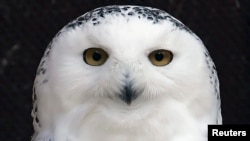The elusive snowy owl, rarely seen outside the Arctic, is turning up more frequently in the skies of North America than it does in the pages of a Harry Potter book, data from the National Audubon Society suggested on Wednesday.
Sightings of the majestic raptors, popularized by the owl Hedwig in author J.K. Rowling's fantasies and the films based on them, could eclipse last season's record when the final tally is in, according to preliminary data from the society's 115th Christmas bird count.
The society is not expected to release the total until June.
It needs to analyze data from an estimated 2,400 counting sessions by teams of volunteers from Dec. 14 to Jan. 5. The countings took place in North, Central and South America, the Caribbean and some South Pacific islands.
As of Wednesday, with just a fifth of the counting sessions totaled, there were 303 of the enormous white birds sighted, Geoff LeBaron, the project leader, said on Wednesday.
Last year's final tally was 1,117 snowy owls, or nearly double the previous high of 563 from the 2011 count, he said.
"This is a big flight," LeBaron said, noting the birds' epicenter seems to be southern Ontario, the Great Lakes and the U.S. Northeast.
It may be the fourth year in a row with a high number of snowy owls, he said. "It probably won't quite reach the level of the one last season or in 2011. But you never know."
Snowy owls breed in the Arctic, where they eat lemmings along with the occasional rabbit, rodent, fish and even fellow birds. Because they typically travel only in search of food, they are rarely seen outside the Arctic, LeBaron said.
"They don't usually come down this far. When they do, it's a real treat," LeBaron said.
Bird experts are not certain why the sightings are more numerous or if they are connected to climate change, LeBaron said.
"People just adore them," he said, adding their popularity among amateur photographers sometimes poses a threat to the animals.
"When people harass them, it's to the detriment of the birds. It can cause them to spend more energy and push them over the edge. If they are starving already, it can cause them to starve to death," LeBaron said.
The birds' natural habitats also can take a beating from crazed fans intent on getting a closeup — especially when they trample fragile dunes like those in New Jersey's Island Beach State Park, where snowy owls have been sighted.
Wildlife officials issued a Facebook plea for bird lovers to stay off the Jersey Shore dunes, located about 80 miles (129 km) southeast of New York City.
"There were no arrests but we just had to ward off some people. Everyone with a cellphone camera wanted to come down to see the snowy owls," said Larry Ragonese, spokesman for the New Jersey Department of Environmental Protection.







